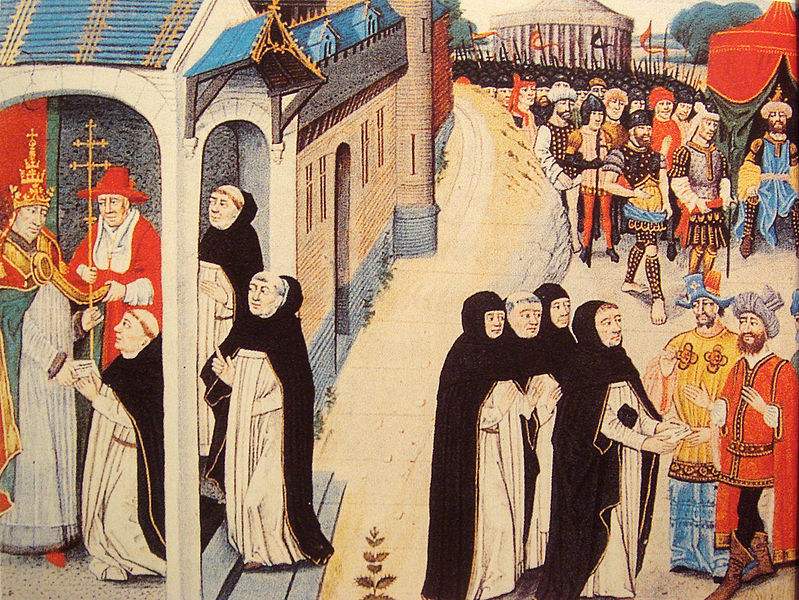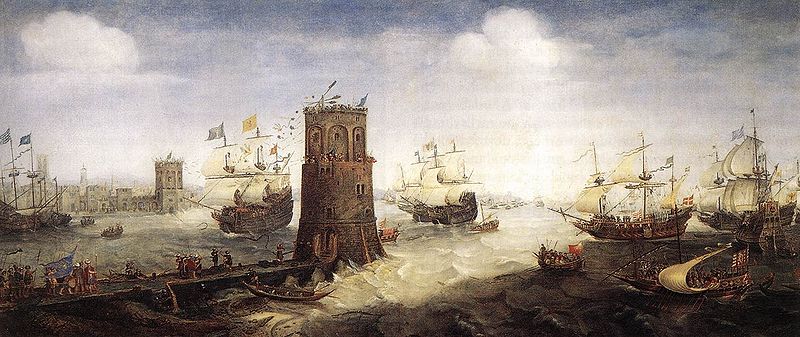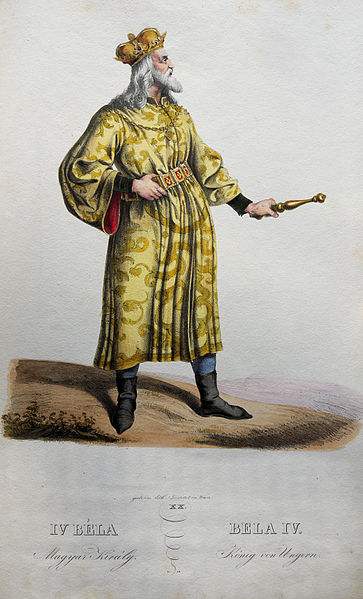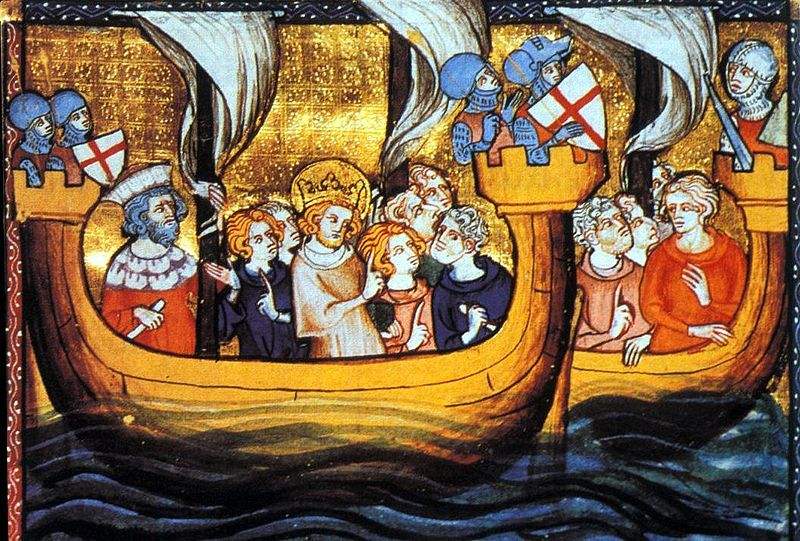II. Foundation of Christian states in the East;
III. First destruction of the Christian states (1144-87);
IV. Attempts to restore the Christian states and the crusade against Saint-Jean d’Acre (1192-98);
V. The crusade against Constantinople (1204);
VI. THE THIRTEENTH-CENTURY CRUSADES (1217-52)
In Europe, however, the preaching of the crusade met with great opposition. Temporal princes were strongly averse to losing jurisdiction over their subjects who took part in the crusades. Absorbed in political schemes, they were unwilling to send so far away the military forces on which they depended. As early as December, 1216, Frederick II was granted a first delay in the fulfilment of his vow. The crusade as preached in the thirteenth century was no longer the great enthusiastic movement of 1095, but rather a series of irregular and desultory enterprises. Andrew II, King of Hungary, and Casimir, Duke of Pomerania, set sail from Venice and Spalato, while an army of Scandinavians made a tour of Europe. The crusaders landed at Saint-Jean d’Acre in 1217, but confined themselves to incursions on Mussulman territory, whereupon Andrew of Hungary returned to Europe. Receiving reinforcements in the spring of 1218, John of Brienne, King of Jerusalem, resolved to make an attack on the Holy Land by way of Egypt.
The crusaders accordingly landed at Damietta in May, 1218, and, after a siege marked by many deeds of heroism, took the city by storm, 5 November, 1219. Instead of profiting by this victory, they spent over a year in idle quarrels, and it was not until May 1221, that they set out for Cairo. Surrounded by the Saracens at Mansurah, 24 July, the Christian army was routed. John of Brienne was compelled to purchase a retreat by the surrender of Damietta to the Saracens. Meanwhile Emperor Frederick II, who was to be the leader of the crusade, had remained in Europe and continued to importune the pope for new postponements of his departure. On 9 November, 1225, he married Isabelle of Brienne, heiress to the Kingdom of Jerusalem, the ceremony taking place at Brindisi. Completely ignoring his father-in-law, he assumed the title of King of Jerusalem.
In 1227, however, he had not yet left for Palestine. Gregory IX, elected pope 19 March, 1227, summoned Frederick to fulfil his vow. Finally, 8 September, the emperor embarked but soon turned back; therefore, on 29 September, the pope excommunicated him. Nevertheless, Frederick set sail again 18 June, 1228, but instead of leading a crusade he played a game of diplomacy. He won over Malek-el-Khamil, the Sultan of Egypt, who was at war with the Prince of Damascus, and concluded a treaty with him at Jaffa, February, 1229, according to the terms of which Jerusalem, Bethlehem, and Nazareth were restored to the Christians. On 18 March, 1229, without any religious ceremony, Frederick assumed the royal crown of Jerusalem in the church of the Holy Sepulchre. Returning to Europe, he became reconciled to Gregory IX, August, 1230. The pontiff ratified the Treaty of Jaffa, and Frederick sent knights into Syria to take possession of the cities and compel all feudatories to do him homage. A struggle occurred between Richard Filangieri, the emperor’s marshal, and the barons of Palestine, whose leader was Jean d’Ibelin, Lord of Beirut. Filangieri vainly attempted to obtain possession of the Island of Cyprus. and, when Conrad, son of Frederick II and Isabelle of Brienne, came of age in 1243, the High Court, described above, named as regent Alix of Champagne, Queen of Cyprus. In this way German power was abolished in Palestine.
In the meantime Count Thibaud IV of Champagne had been leading a fruitless crusade in Syria (1239). Similarly the Duke of Burgundy and Richard of Cornwall, brother of the King of England, who had undertaken to recover Ascalon, concluded a truce with Egypt (1241). Europe was now threatened with a most grievous disaster. After conquering Russia, the Mongols under Jenghiz Khan appeared in 1241 on the frontiers of Poland, routed the army of the Duke of Silesia at Liegnitz, annihilated that of Bela, King of Hungary, and reached the Adriatic. Palestine felt the consequences of this invasion. The Mongols had destroyed the Mussulman Empire of Kharizm in Central Asia. Fleeing before their conquerors, 10,000 Kharizmians offered their services to the Sultan of Egypt, meanwhile seizing Jerusalem as they passed by, in September, 1244. The news of this catastrophe created a great stir in Europe, and at the Council of Lyons (June-July, 1245) Pope Innocent IV proclaimed a crusade, but the lack of harmony between him and the Emperor Frederick II foredoomed the pontiff to disappointment. Save for Louis IX, King of France, who took the cross in December, 1244, no one showed any willingness to lead an expedition to Palestine. On being informed that the Mongols were well-disposed towards Christianity, Innocent IV sent them Giovanni di Pianocarpini, a Franciscan, and Nicolas Ascelin, a Dominican, as ambassadors.

Pope Innocent IV send Giovanni di Pianocarpini, a Franciscan, and Nicolas Ascelin, a Dominican to the Mongol general Baiju.
Pianocarpini was in Karakorum 8 April, 1246, the day of the election of the great khan, but nothing came of this first attempt at an alliance with the Mongols against the Mohammedans. However, when St. Louis, who left Paris 12 June, 1248, had reached the Island of Cyprus, he received there a friendly embassy from the great khan and, in return, sent him two Dominicans. Encouraged, perhaps, by this alliance, the King of France decided to attack Egypt. On 7 June, 1249, he took Damietta, but it was only six months later that he marched on Cairo. On 19 December, his advance-guard, commanded by his brother, Robert of Artois, began imprudently to fight in the streets of Mansurah and were destroyed. The king himself was cut off from communication with Damietta and made prisoner 5 April, 1250. At the same time, the Ajoubite dynasty founded by Saladin was overthrown by the Mameluke militia, whose ameers took possession of Egypt. St. Louis negotiated with the latter and was set at liberty on condition of surrendering Damietta and paying a ransom of a million gold bezants. He remained in Palestine until 1254; bargained with the Egyptian ameers for the deliverance of prisoners; improved the equipment of the strongholds of the kingdom, Saint-Jean d’Acre, Cæsarea, Jaffa, and Sidon; and sent Friar William of Rubruquis as ambassador to the great khan. Then, at the news of the death of his mother, Blanche of Castile, who had been acting as regent, he returned to France.
Since the crusade against Saint-Jean d’Acre, a new Frankish state, the Kingdom of Cyprus, had been formed in the Mediterranean opposite Syria and became a valuable point of support for the crusades. By lavish distribution of lands and franchises, Guy de Lusignan succeeded in attracting to the island colonists, knights, men-at-arms, and civilians; his successors established a government modeled after that of the Kingdom of Jerusalem. The king’s power was restricted by that of the High Court, composed of all the knights, vassals, or under-vassals, with its seat at Nicosia. However, the fiefs were less extensive than in Palestine, and the feudatories could inherit only in a direct line. The Island of Cyprus was soon populated with French colonists who succeeded in winning over the Greeks, upon whom they even imposed their language. Churches built in the French style and fortified castles appeared on all sides. The Cathedral of St. Sophia in Nicosia, erected between 1217 and 1251, was almost a copy of a church in Champagne. Finally, commercial activity became a pronounced characteristic of the cities of Cyprus, and Famagusta developed into one of the busiest of Mediterranean ports.
LOUIS BRÉHIER (Catholic Encyclopedia)














